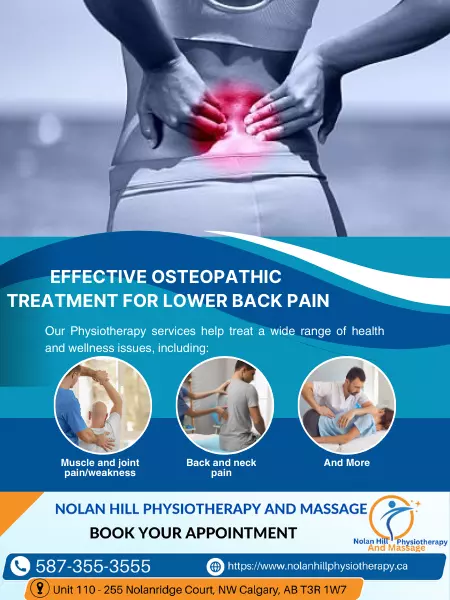Effective Osteopathic Treatment for Lower Back Pain
Back pain can be a persistent and frustrating experience that affects many individuals worldwide. The impact of back pain can be debilitating, resulting in a reduced quality of life, limited mobility, and even depression.
While traditional treatments for back pain, such as medication or surgery, can be effective, they are not always ideal for everyone. This is where osteopathy comes in as an alternative and holistic approach to treating back pain.
Osteopathy is a form of manual therapy that focuses on the musculoskeletal system to promote overall health and wellbeing. This alternative medicine approach seeks to treat the underlying cause of back pain by addressing the whole body, rather than just the affected area. By using techniques such as joint movement, mobilisation, stretching, and massage, osteopathy can provide individuals with safe and effective relief from back pain without the need for medication or invasive procedures.
In this complete guide, we will explore the techniques used in osteopathy for back pain, how diagnosis is made, and the benefits of this holistic approach to the musculoskeletal system. Through this guide, individuals can gain a deeper understanding of osteopathy and how it can help them say goodbye to back pain and hello to a pain-free life.
Key Takeaways
– Osteopathy is a complementary or alternative medicine that focuses on treating the whole body, using joint movement, mobilisation, stretching, and massage to detect, treat, and prevent health problems.
– Osteopathic treatment for back pain involves various manual techniques such as massage, spinal manipulation, muscle energy technique, counterstrain technique, and cranial osteopathy, and is effective in treating various back conditions.
– Osteopathy is generally considered a safe and effective remedy for back pain, with no side effects other than soreness for one to two days after manual therapy.
– Effective communication between therapist ( osteopath for lower back pain) and patient is crucial for successful treatment, and patients are encouraged to follow their practitioner’s advice for posture, stretching, lifting, and body mechanics.
What is Osteopathy?
Osteopathy is a complementary or alternative medicine that has been developed over the years to focus on detecting, treating, and preventing health problems using joint movement, mobilisation, stretching, and massage. This non-invasive manual treatment aims to strengthen the musculoskeletal frameworks to increase or restore joint mobility, relieve muscle tension, reduce pain and stiffness in muscles and joints, improve blood flow, and enhance tissue elasticity.
Osteopathy is effective in treating various back conditions such as generalised aches and pains, joint pain, rheumatic pain, sciatica, pregnancy back pain, posture problems, muscular tension, muscular spasm, neck pain, shoulder pain, mechanical back pain, secondary and compensatory problems arising from spinal disc problems, sporting injuries and tensions, osteoarthritis, headaches, and migraines, and digestive problems.
Osteopathy is often compared to other manual therapies such as physiotherapy and chiropractic care, but it is unique in its holistic approach to the musculoskeletal system. Osteopaths take a thorough case history and examination, analyzing X-rays, scans, and other tests to make a diagnosis before using a wide range of manual treatments depending on the patient’s diagnosis, age, and overall fitness.
Unlike chiropractic care, osteopath for back pain does not focus solely on spinal manipulation but rather looks at the whole body to address the root cause of the problem. While physiotherapy focuses on rehabilitation and exercise, osteopathy uses manual therapy to treat the underlying issue.
Osteopathy is generally considered a safe and effective remedy for back pain with no side effects other than soreness for one to two days after manual therapy. Private Health Insurance providers often cover osteopathy, but it is not widely available on the NHS.
Browse: Osteopath manual therapy for knee pain in NW Calgary
Techniques for Back Pain:
Various manual techniques are used by osteopath for back pain to alleviate back pain, including massage, spinal manipulation, muscle energy technique, counterstrain technique, and cranial osteopathy. Massage is a popular technique that involves manipulating the soft tissues of the body to improve circulation, reduce muscle tension, and promote relaxation. It can be performed by hand or with a massage tool and can range from gentle to deep pressure. Spinal manipulation, on the other hand, involves the application of pressure to the spine to improve joint mobility, reduce pain, and restore function. It can be performed by hand or with a specialized tool and may produce a popping or cracking sound.
Browse: Osteopathic Manual Therapy NW Calgary
Muscle Energy Technique (MET) and Counterstrain Technique are two other manual techniques that can be used to alleviate back pain. MET involves the use of muscle contractions to improve joint mobility and reduce pain. It is often used in conjunction with other manual techniques and can be performed by the practitioner or the patient. Counterstrain Technique, on the other hand, involves the application of pressure to specific points on the body to reduce muscle tension and improve joint mobility. It is a gentle technique that can be used on patients of all ages and is often used in conjunction with other manual techniques. The table below provides a summary of these techniques and their benefits.
Technique | Description | Benefits |
Massage | Manipulating soft tissues to improve circulation, reduce muscle tension, and promote relaxation | Improved circulation, reduced muscle tension, relaxation |
Spinal Manipulation | Applying pressure to the spine to improve joint mobility, reduce pain, and restore function | Improved joint mobility, reduced pain, restored function |
Muscle Energy Technique | Using muscle contractions to improve joint mobility and reduce pain | Improved joint mobility, reduced pain |
Counterstrain Technique | Applying pressure to specific points on the body to reduce muscle tension and improve joint mobility | Reduced muscle tension, improved joint mobility |
Myofascial Release Technique | Applying sustained pressure to the myofascial tissues to release restrictions and improve mobility | Improved mobility, reduced pain and tension in the affected area |
Benefits of Osteopathy
One of the key advantages of manual therapy techniques for treating back pain is their ability to improve joint mobility, reduce pain, and promote relaxation, ultimately leading to a better quality of life for those suffering from chronic discomfort.
Osteopathy, in particular, provides drug-free, non-invasive manual treatment that strengthens the musculoskeletal frameworks, reduces muscle tension, and enhances tissue elasticity, resulting in long-term benefits beyond simply treating the pain.
In addition to treating existing back pain, osteopathy also offers preventative measures to reduce the risk of future pain and injury. Osteopaths advise on the right posture, stretching, and other activities that help relieve pain and improve overall body function, which can improve the health of other body systems, such as the digestive, circulatory, and respiratory systems.
Effective communication between osteopath for lower back pain and patient is crucial for successful treatment, and patients are encouraged to follow their practitioner’s advice for posture, stretching, lifting, and body mechanics.
Overall, osteopathy offers a holistic approach to the musculoskeletal system, promoting long-term benefits and an improved quality of life.
Browse: Osteopathic Massage Therapist NW Calgary
Getting Treatment
Patients seeking osteopathic treatment for back pain can book a free 15-minute consultation with a qualified and registered therapist at Nolan Hill Physiotherapy & Massage NW Calgary, where treatment options are discussed in detail with the patient.
During the consultation, the osteopath for back pain will ask about the patient’s medical history, perform a physical examination, and may recommend lab tests or X-rays to determine the best course of treatment.
Patients are encouraged to ask questions and discuss any concerns they may have before proceeding with treatment.
It is important to find a qualified osteopath when seeking treatment for back pain.
While osteopathy is a regulated practice, patients should still do their research to ensure that the practitioner they choose is properly licensed and trained.
Browse: OSTEOPATH FOR HIP PAIN IN NW CALGARY
Patients should also follow their practitioner’s advice for posture, stretching, and other activities that can help relieve pain and prevent further injury.
Frequently Asked Questions
Are there any risks or potential side effects associated with osteopathic treatment for back pain?
Osteopathic treatment for back pain is generally safe and effective, with potential risks being soreness for a day or two after manual therapy. Safety precautions include thorough diagnosis, communication with the patient, and following the practitioner’s advice.
Can osteopathy be used as a preventative measure for back pain, or is it only effective for treating existing pain?
Osteopathy can provide preventative benefits for back pain by improving musculoskeletal function and promoting proper posture and body mechanics. Long term effectiveness is dependent on patient participation and following practitioner advice for maintaining a healthy spine.
How many sessions of osteopathic treatment are typically required to see a significant improvement in back pain?
The frequency of osteopathic treatment required for significant improvement in back pain varies depending on the individual’s diagnosis, age and overall fitness. Cost effectiveness may also be a factor to consider.
What type of training and qualifications do osteopaths have, and how can patients ensure they are receiving treatment from a qualified practitioner?
What training and qualifications do osteopaths have? Osteopaths require a bachelor’s degree in osteopathy and must be registered with the General Osteopathic Council. Patients can verify a practitioner’s qualifications on their website.
Are there any lifestyle changes or additional therapies that patients can incorporate alongside osteopathy to further improve their back pain?
Lifestyle modifications, such as maintaining a healthy weight, avoiding prolonged sitting, and engaging in regular exercise, can improve back pain. Complementary therapies, such as acupuncture, yoga, and mindfulness meditation, may also provide additional relief and support when combined with osteopathy.

